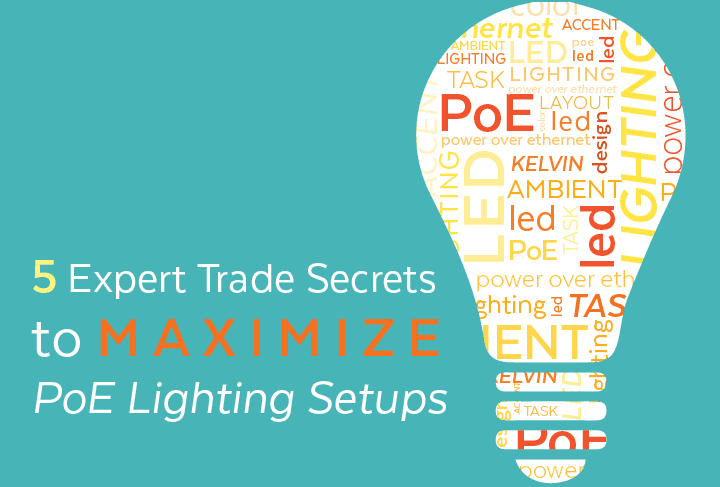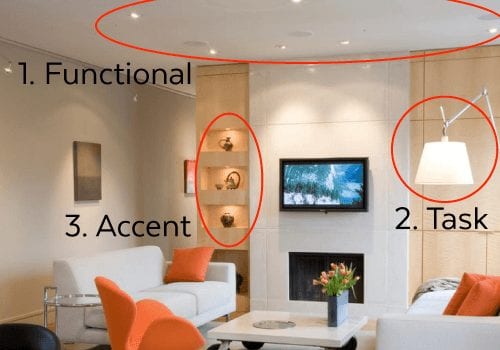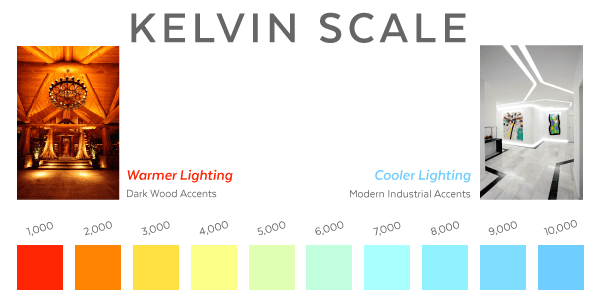If you’ve kept up with the news, you know that LED’s are definitely here to stay. They’re more energy-efficient, more versatile, and that’s hardly the half of it. They also play nice with PoE networking equipment.
I hear your silent protests. Yes, many times you’ll be working in conjunction with designers who will probably guide the lighting design process from start to finish.
But as PoE lighting installations become more and more prevalent, you’ll soon find it increasingly easy to handle this aspect of installations yourself.
By taking care of lighting design and install in-house, you’ll…
- Save your customer time and money
- Add value to what you offer your clients
- Add revenue to your existing business
- Earn some serious customer loyalty
Arm yourself with the right knowledge ahead of time, and you’ll find that this is an extremely simple cross-sell. In fact, it can be a no-brainer for your clients.
Take the time to get your facts and figures straight, and before you know it you’ll be an authority on the subject. Your advice will be worth it’s weight in gold and you won’t even need to outsource lighting to a designer.
With that in mind, let’s learn how interior lighting design works and how we can make the most of modern and efficient lighting systems.
Why Do Designers Place Such Importance on Light
The short version? Lighting is the unsung hero in the majority of inspiring rooms and structures.
“Lighting can make a space; it can be aesthetic or functional. From lighting up your art to providing reading light, it is a necessary feature in any space.” -Sherry Burton
You could design the most amazing contemporary office space, but without the right lighting it could easily end up looking like just another cubicle farm.
We want to go above and beyond though. We want to bring a space to life through both aesthetic and functional lighting.
Light brings visual warmth. It attracts attention and is even (at least somewhat) responsible for the “mood” people find themselves in when they’re occupying a room. And yes, these principles apply to building exteriors as well.
LED lighting is particularly convenient for the very fact that it comes in different shapes, colors, and levels of intensity. This versatility makes it far simpler to set (and later adjust) the mood of an environment.
“As some of the objects that use up the most amount of energy in households, it is important to… make sure that your fixtures are sustainable and environmentally friendly.” – Sherry Burton
OK, so now that we know why lighting deserves careful attention, let’s take a closer look at some of the techniques top design professionals employ.
5 Things Experts Consider When Using PoE Lighting Setups
By growing familiar with these professional PoE lighting installation techniques, we (as installers) can mimic them and up sell our own clients in the future.
For our article today, we’ve enlisted the help of Sherry Burton whom you saw quoted above. Sherry has appeared in the likes of Forbes.com, Rodale’s Organic Life, and CBS Radio. She’s an author, speaker and coach, and she was generous enough to share a ton of great information with us!
In case you’re curious, her book, Feel-Good Spaces: A Guide to Decorating Your Home For Body, Mind and Spirit received consistent 4.5 out of 5 star reviews on Amazon, and a 5-star review from Houzz.
For someone so centered on holistic design, it’s a bit surprising that Sherry began her career in a particularly technical industry – transportation planning. While working closely with civil engineers, she learned a number of crucial lessons about shaping communities and public places.
Without further ado, let’s take a look at some of the pointers Sherry collaborated with us to come up with.
1. Physical Layout
When you first start working on a lighting installation, be particularly mindful of the physical layout and architecture featured in the space.
Also, take note of the placement of art and furniture throughout the environment. These are elements you may want to draw special attention to with lighting.
Notice how the recessed lighting follows down the hallway in the following picture. This is a perfect example of how to add dimension to an otherwise narrow passage.
2. Different Lights for Different Purposes
Newcomers to the world of lighting design, may be surprised to learn that lighting installations are planned in “layers”.
First a designer considers functional lighting. Afterwards, decorative and ambient lighting are given their due attention.
By following this methodology, it’s much easier to add dimension to what is otherwise just a room. Keep in mind that each of those layers will have different kinds of lighting fixtures.
For example, ambient lights should usually be installed with dimmers.
There’s too much to cover here, but https://www.kichler.com/style-guide/learn-about-lighting/layer-your-lighting.aspx check out this guide to learn more if you’re ready for a deep dive.
3. Color Choice Matters
This one is common sense. You probably wouldn’t put purple drapes in a room with teal decorations. Colors are always something to consider.
Your light sources will be no different in this regard. They should complement and coalesce seamlessly with the room’s furniture and decorations.
For example, if the space you’re designing a lighting installation for features dark wood accents, warm light tones will be most suitable.
If you’re not sure what the different light tones are, don’t worry. It’s simple. The lower range a light source ranks on the Kelvin scale, the “warmer” the tone (yellow). As the Kelvin reading increases, light tones become “cooler” (white).
We covered this topic in depth a few weeks ago, feel free to visit that article if you’re looking for some more in-depth knowledge on how to pick lighting for workspace installations.
4. Light Can Balance Other Design Elements
While we’re on the subject of color, it should be noted that other colors featured in the space shouldn’t fight with lighting either.
Be careful to choose lighting that compliments the wall color. Don’t overpower it, or give it too much weight by over-emphasizing the wall color either.
In the example below, notice how the cool white light from the track lighting fixture allows different shades of white in the furnishings and rug to stay “true”? That’s intentional, and smart design.
The wall sconce, however, is a warmer light. It’s there to warm the cream background, providing soft ambient light.
Replicating this process on your own might seem difficult at first, but with a little common sense, and some research, it won’t be too challenging. In fact, it wouldn’t hurt to have a quick cheat sheet about what lighting tones go with what colors and accents.
Here’s just that. A guide to colors and lighting. And here’s another guide on how colors and light interact with one another.
Design Tip: Cat5 or Twisted Pair cable reduces the degree of difficulty for installing and powering LEDs in architecturally remote locations.
5. Understand How People Will Use and Move Through The Space
Whether we notice it or not, we’re all influenced by lighting design. Subtle cues can lead our attention to certain areas in rooms, or pathways.
When you’re designing a lighting installation, keep in mind what area of the room you want to highlight and be sure to focus a decent amount of the light there.
Brighter light draws eyes in that direction. Simple and effective.
In the example below, see how the bright spots in the room are the two seating areas, and the kitchen? These are the focal points of this environment, and the lighting indicates so without being distracting.
Final Thoughts on Lighting
You can make a room pretty with colors and furnishings, but without the right lighting design, it will all be for naught.
LED lighting fixtures enable greater versatility for creative choices, and their ease of use and installation opens the door for easy cross sells that you may never have considered before.
If you decide to get your feet wet, be sure to choose lighting that compliments and accentuates the existing space. Focus on emphasizing comfort and usability.
If you have questions, don’t hesitate to reach out to our technicians who can get you set up with all of the gear you’ll need for a successful installation.



